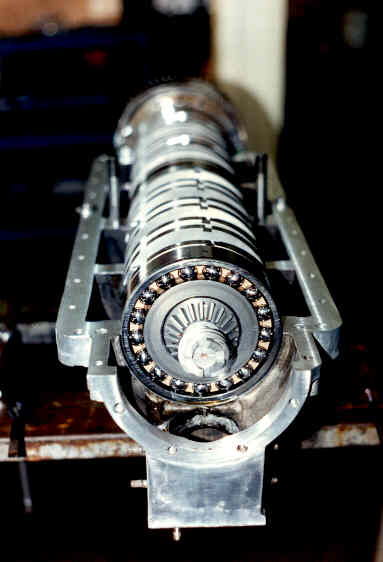Vortex347 wrote:I personally reckon a v10 would be better than a v12 especially in regards to the weight aspect you mentioned in your opening post (v10 engine would be lighter than v12 and less complex).
Cosworth built a V12 "mule" before V10 engines were mandated and the conclusion was that the V12 wasn't beneficial, at least at that time.
Vortex347 wrote:First and foremost, the power aspect of the cars wouldn't really be comparable to what they were running in the past. My main reason for this is the introduction of Direct Injection in the 2014 turbo v6 engines compared to multi port fuel previously.
The advantages of direct injection (over MPFI) in regards to power are huge.
Running DI on these new engines would yield more power due to the fact that DI doesn't spray fuel into the cylinder until the instant it needs it for the combustion cycle. This means you could run a higher compression ratio and not have to worry about engine knock. Higher compression ratio = bigger bang = more power (possibly a significant torque increase too due to the extra force the piston is being subjected to).
Mazda's new skyactiv technology (uses DI on petrol engines) and enables compression ratios of 13:1 (a huge thing to take note of with this is the engines aren't built from any exotic materials, have a large safety margin and large reliability margin for longevity). Take into account some Dirt bikes made by ktm and yamaha are pushing 14:1 + on their 250cc four strokes also using fairly ordinary materials (AND no pneumatic valves either) well...
It'd be pretty hard to gauge what these guys could come up with but with the DI compared to MPFI and beefed up comp. ratio. I'd say 16:1 would be a walk in the park for these guys, you'd probably be looking at a 10-16% power increase assuming the engines are revving the same. In regards to rpm I think 22000 rpm is the maximum these engines could rev to before they start being overcome by large amounts of friction (which would sap power). compared to the honda at the start that'd be another 10-13% power so all up you'd be looking at maybe 25% on top of that 950hp.
Direct injection will not have a major influence on the maximum power of an air restricted naturally aspiranted engine. You typically see some improvement in volumetric efficiency as you lose the fuel vapors in the inlet and some improvement in knock resistance but the NA F1 engines were never knock limited. This means that the compression ratio for F1 engines could be selected without regard to knock, instead it was a compromise between the higher thermal efficiency of a higher compression ratio, the associated losses caused by the increased cylinder pressures (increased frictional- and heat losses), airflow restrictrions around the inlet valves and particularly the negative impact on the combustion by the shape of the combustion chamber with a high CR short stroke engine.
For maximum power out of a given airflow a direct injected engine injects the fuel during the intake stroke, as this gives the most homogeneous mixture for combustion.
Vortex347 wrote:
In terms of engine weight well steel crankshaft is the Achilles heel of lightweight engines in f1. Get rid of that and replace it with something a lot lighter and that 95kg engine will be down to about 85kg.
Lighter crankshaft would also have lower rotational inertia so more power to the wheels there.
For lightweight and durability though it's pretty hard to beat magnesium and there have been a lot of breakthroughs in making it corrosion resistant (through the use of stainless alloys and magnesium) and neutralizing it's spontaneous combustion properties (by adding silicon molecules I believe)
http://www.gizmag.com/stainless-magnesi ... ash/28856/
If it's possible to make an engine block out of stainless magnesium well the possibilities are endless. This would easily supersede steel, cast iron, aluminium, titanium and beryllium too (an illegal material in f1 atm). I reckon about 65kg overall so about 25kg lighter than the old engines.
Steel (with tungsten counter weights) is a very difficult material to beat for crankshafts. A material used in crankshafts must offer a very high fatigue strength (to prevent failure at high cyclic stress), a high surface hardness (to prevent wear on bearing surfaces) and a high stiffness (to allow a compact design). Magnesium doesn't offer any of those properties.
Magnesium is typically used as an alternative to aluminium or plastics in low temperature applications. As an alternative to aluminum it's lower density, but also lower stiffness, means it can be used to make lighter parts that are limited by geometry rather than strength, or allow better strength to weight ratio by increasing the wall thickness of the part (a lower density material made with greater thickness is stiffer in bending that a higher density material with a smaller thickness, albeit the same specific stiffness). Magnesium is an unnoble material so corrosion will always be an issue, like aluminium certain alloying elements can increase corrosion resistance although this typically does have a negative impact on other properties. Magnesium catching fire is typically not a problem with thick walled parts, like cylinder heads, engine covers and so on. Magnesium sheet is however banned for a good reason.
gruntguru wrote:Not many engines using roller bearings any more.
The Peugeot/Asiatech V10 was probably the only F1 engine of that time to use roller bearings for the mains. I know Ferrari made a few prototypes in the early nineties with rollers (using an assembled crankshaft I believe), but rollers were generally regarded not to offer a friction reducion at F1 speeds.




